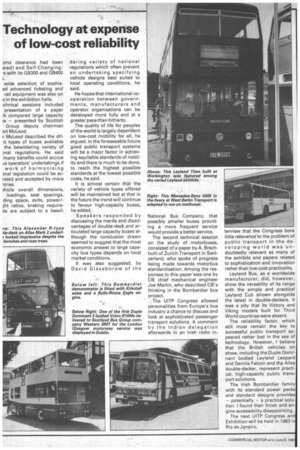Technology at expense of low-cost reliability
Page 50

If you've noticed an error in this article please click here to report it so we can fix it.
Dms clearance had been wed) and Self-Changing-s with its GB300 and GB400
wide selection of sophised advanced ticketing and rail equipment was also on v in the exhibition halls.
,chnical sessions included presentation of a paper :h compared large capacity — presented by Scottish Group deputy chairman rt McLeod.
r McLeod described the dif-it types of buses available the bewildering variety of prial regulations. He said many benefits could accrue Js operators' undertakings if work of harmonising 3nal legislation could be aerated and accepted by more
.hicle overall dimensions, loadings, seat spacings, ding space, exits, power!ht ratios, braking requireits are subject to a bewil dering variety of national regulations which often prevent an undertaking specifying vehicle designs best suited to local operating conditions, he said.
He hopes that international cooperation between governments, manufacturers and operator organisations can be developed more fully and at a greater pace than hitherto.
The quality of life for peoples of the world is largely dependent on low-cost mobility for all, he argued. In the foreseeable future good public transport systems will be a major factor in achieving equitable standards of nobility and there is much to be done, to reach the highest possible standards at the lowest possible costs, he said.
It is almost certain that the variety of vehicle types offered will be maintained but at that in the future the trend will continue to favour high-capacity buses, he added.
Speakers responded by discussing the merits and disadvantages of double-deck and articulated large capacity buses although the conclusion drawn seemed to suggest that the most economic answer to large capacity bus types depends on local market conditions.
It was also suggested, by David Glassborow of the National Bus Company, that possibly smaller buses providing a more frequent service would provide a better service.
The second technical session on the study of motorbuses, consisted of a paper by A. Brechbuhl of Zurich Transport in Switzerland, who spoke of progress being made towards motorbus ,standardisation. Among the responses to this paper was one by CIE chief mechanical engineer Joe Martin, who described CIE's thinking in the Bombardier bus project.
The UITP Congress allowed personalities from Europe's bus industry a chance to discuss and look at sophisticated passenger transport solutions. A comment by the Indian delegation afterwards in an Irish radio in terview that the Congress bore little relevance to the problem of public transport in the developing world was undoubtedly relevant as many of the exhibits and papers related to sophistication and innovation rather than low-cost practicality.
Leyland Bus, as a worldwide manufacturer, did, however, show the versatility of its range with the simple and practical Leyland Cub shown alongside the latest in double-deckers. It was a pity that its Victory and Viking models built for Third World countries were absent.
The reliability factor, which still must remain the key, to successful public transport appeared rather lost in the sea of technology. However, I believe that the British vehicles on show, including the Duple Dominant bodied Leyland Leopard and Dennis Falcon and the Ailsa double-decker, represent practical, high-capacity public transport solutions.
The Irish Bombardier family with its standard power packs and standard designs provides — potentially a practical solution. I found their finish and engine accessibility disappointing.
The next UITP Congress and Exhibition will be held in 1983 in Rio de Janeiro.












































































































